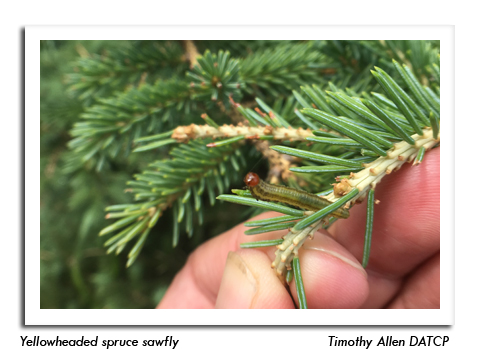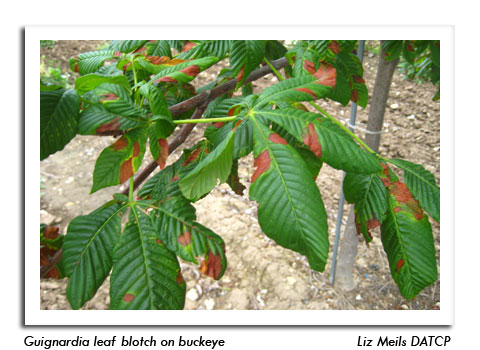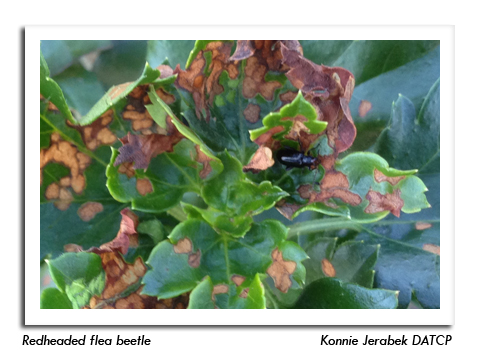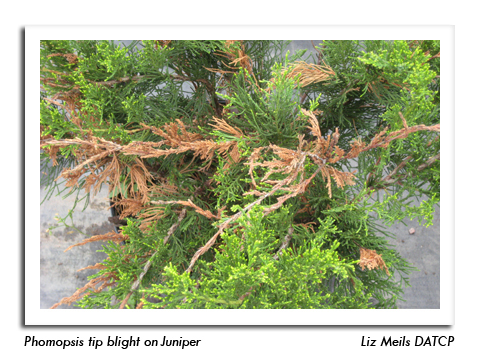
 |
|
|
Nursery & Forest
Volume 64 Number 13 Date 07/25/2019 YELLOWHEADED SPRUCE SAWFLY - Light but widespread damage from the larvae of this insect was noted on white spruce trees in Oneida County. The yellowheaded spruce sawfly feeds on any type of spruce, though open-grown, 3 to 5-year-old trees are preferred, making this species a pest of Christmas trees and nursery spruce. Early in summer the larvae feed mainly on new growth, later moving to older growth where they cause noticeable defoliation in the upper branches. Repeated years of severe defoliation can lead to top dieback or even tree mortality. GUIGNARDIA LEAF SPOT - The large, blotchy leaf spots common on buckeye trees are symptoms of this fungal disease, caused by the pathogen Guignardia aesculi. The reddish-brown blotches with yellow margins may lead to early defoliation when infection is severe, particularly during wet summers. Removal and destruction of fallen leaves may help reduce infection in future years. Because this disease is primarily aesthetic and does not threaten the long-term survival of the tree, chemical control is not advised. REDHEADED FLEA BEETLE - These shiny black beetles with prominent reddish heads are abundant in scattered cornfields from Dane to Marathon County. Nurseries are also likely to be impacted given the high numbers observed. Defoliation caused by flea beetle feeding varies by leaf type, appearing as skeletonizing or shredding on thinner leaves and a linear, leafminer-like pattern on the thicker, fleshy leaves of sedum and similar plants. Insecticides directed against the adults can be considered if beetle feeding is impacting the aesthetic quality and marketability of stock. A few cultivars highly susceptible to RHFB damage include Virginia sweetspire 'Little Henry,' hydrangea 'Vanilla Strawberry' and 'Bobo,' red osier dogwood 'Kelseyi,' and weigela 'Fine Wine.' -- Timothy Allen, DATCP Nursery Inspector PEAR SAWFLY - Serviceberry shrubs at a nursery grower in Dane County were infested with larval pear sawflies. The black, slug-like larvae feed on the upper surface of leaves of many ornamental and fruit trees such as cherry, cotoneaster, mountain ash and pear, causing leaf skeletonization similar to Japanese beetle damage. Larvae first appear in June, feed for a month, then drop to the soil to pupate. A second generation appears in late August or September. Pear sawfly damage is largely cosmetic, but several control options are available, including manual removal, horticultural oils and insecticidal soaps. PHOMOPSIS TIP BLIGHT - Nursery inspectors report that this evergreen disease was infecting several balsam fir, red pine and spruce trees at a Portage County nursery field. Plants with Phomopsis blight develop yellow spots at the shoot tips of young needles that progress to the stems, causing gradual dieback of new growth and eventual death of the infected branch. The black pycnidia or fruiting bodies which develop on the dead branches are diagnostic. The occurrence of Phomopsis can be reduced by pruning out symptomatic branches and twigs 4-6 inches below the diseased area, and disinfecting pruning shears between cuts. Maintaining adequate spacing and airflow between plantings will also help to prevent its spread. -- Shanon Hankin, DATCP Nursery Inspector 




|
|
|